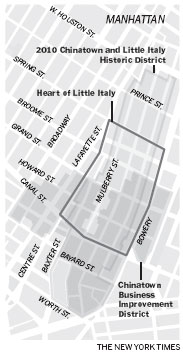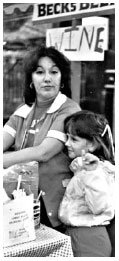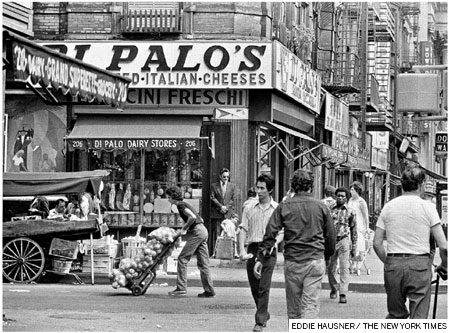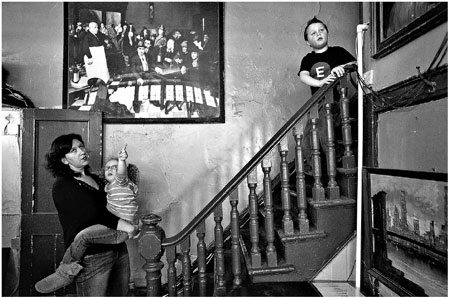Society
The world closes in on Little Italy
Updated: 2011-04-17 07:47
By Sam Roberts (New York Times)
|
Little Italy, once a 50-block enclave, has shrunk as Chinatown has encroached and Italians have moved out. Grand Street at Mott Street in 1974, right. The owners of DiPalo's have worked to make it a destination as Little Italy has changed. |
 |
Little Italy, once the heart of Italian-American life in the city, exists mostly as a memory.
In 1950, nearly half of the more than 10,000 New Yorkers living in the heart of Little Italy identified as Italian-American.
By 2000, the census found that the Italian-American population had dwindled to 6 percent. Only 44 were Italian-born, compared with 2,149 a half-century earlier.
A census survey released in December determined that the proportion of Italian-Americans among the 8,600 residents in the same two-dozen-square-block area of Lower Manhattan had shrunk to about 5 percent.
And, incredibly, the census could not find a single resident who had been born in Italy.
The only streets that really feel like they belong to Little Italy, Mulberry and Grand, are still crammed with venerable Italian restaurants and shops. But Chinese-language advertisements pepper the sidewalk.
The Gambino crime family's old social club at 247 Mulberry is now a shoe and handbag boutique. In January, more than 100 reputed members of mob families were charged with federal crimes; none lived in Little Italy.
Sambuca's Cafe, at 105 Mulberry Street, is listed by Yelp, the food-oriented Web site, as being in Chinatown - particularly humiliating because it is owned by the president of the Little Italy Merchants Association.
Of the 8,600 residents counted by the census in the heart of Little Italy in 2009, nearly 4,400 were foreign-born. Of those, 89 percent were born in Asia. In 2009, a Korean immigrant won a tenor competition sponsored by the Little Italy Merchants Association. And a Chinese immigrant, Margaret S. Chin, was elected to represent the district in the City Council.
|
Natalie Diaz, 34, left, with her children, Johnny and Anna, at the Mulberry Street Bar, which her family owns. Above, Ms. Diaz in 1982 with her aunt Vivian Catenaccio at the family's food stand. Joshua Bright for The New York Times |
 |
The City Planning Commission is poised to approve the creation of a Chinatown Business Improvement District, which would engulf all but about two square blocks of a haven that once spanned almost 50 square blocks and had the largest concentration of Italian immigrants in the United States.
"When the Italians made money they moved out to Queens and New Jersey, they sold to the Chinese, who are now selling to the Vietnamese and Malaysians," said Ernest Lepore, 46, who, with his brother and mother, owns Ferrara, an espresso and pastry shop his family opened 119 years ago.
Still, some residents cling to a neighborhood that is rich in history and culture.
Natalie Diaz's children are the fifth generation of a family that arrived from Naples in 1916. She still lives in the building where she grew up. Her husband's parents were Irish and Puerto Rican.
"Little by little, everyone wants a little more, more space, and moves away," said Ms. Diaz, 34.
Cleanliness, quaintness and low crime have broadened the neighborhood's appeal, which has driven up rents. The owners of a two-bedroom co-op on Grand Street are asking $1.5 million.
Still, some Little Italy landmarks appear to be thriving, thanks mostly to tourists.
Lou Di Palo took over Di Palo's, an Italian specialty food store that opened in 1903, from his ailing father in 1990. The nearby Alleva dairy, which advertises itself as the nation's oldest Italian cheese store, opened in 1892. Fifth-generation family members work in both stores.
"We're going to take our business and go backwards - focus the way our grandparents and great-grandparents ran their operation: family-oriented," Mr. Di Palo said.
Ms. Diaz says tradition binds her to the neighborhood. "I owe it to my ancestors," she said.
The New York Times
E-paper

Han me downs
Traditional 3,000-year-old clothes are making a comeback.
Reaching out
Fast growth fuels rise in super rich
Chinese tourists spend more
Specials

Big spenders
More mainland tourists are expected to spend money on overseas travel this year.

Rise in super rich
Report cites rising property prices, gdp as key drivers of increasing number of chinese millionaires.

Reaching out
Condom makers are stepping up their presence in smaller cities to boost sales


